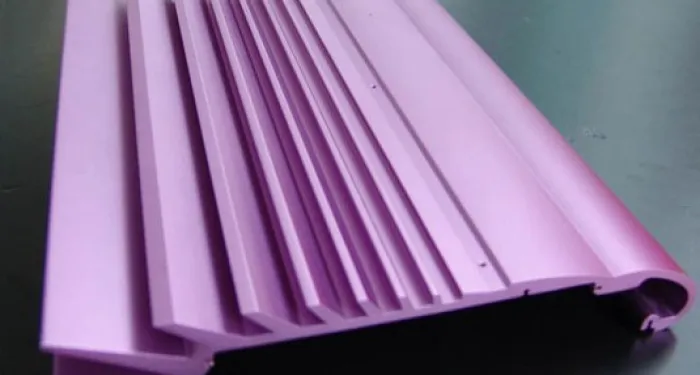
News
News

Aluminum Alloys Versus Other Steels
Aluminum alloys typically have an elastic modulus of about 70 GPa, which is about one-third of the elastic modulus of most kinds of steel and steel alloys. Therefore, for a given load, a component or unit made of an aluminum alloy will experience a greater elastic deformation than a steel part of the identical size and shape. Though there are aluminum alloys with somewhat-higher tensile strengths than the commonly used kinds of steel, simply replacing a steel part with an aluminum alloy might lead to problems.
With completely new metal products, the design choices are often governed by the choice of manufacturing technology. Extrusions are particularly important in this regard, owing to the ease with which aluminum alloys, particularly the Al–Mg–Si series, can be extruded to form complex profiles. Aluminum alloys such as aluminum alloy 7020 are widely used in engineering structures and components where light weight or corrosion resistance is required.
In general, stiffer and lighter designs can be achieved with aluminum alloys than is feasible with steels. For instance, consider the bending of a thin-walled tube: the second moment of area is inversely related to the stress in the tube wall, i.e. stresses are lower for larger values. The second moment of area is proportional to the cube of the radius times the wall thickness, thus increasing the radius by 26% will lead to a halving of the wall stress. 6061 aluminum alloy is a precipitation hardening aluminum alloy, containing magnesium and silicon as its major alloying elements. Originally called "Alloy 61S," it was developed in 1935. For this reason, bicycle frames made of aluminum alloys make use of larger tube diameters than steel or titanium in order to yield the desired stiffness and strength. In automotive engineering, cars made of aluminum alloys employ space frames made of extruded profiles to ensure rigidity. This represents a radical change from the common approach for current steel car design, which depends on the body shells for stiffness that is a unibody design.
Aluminum alloys are widely used in automotive engines, particularly in cylinder blocks and crankcases due to the weight savings that are possible. Since aluminum alloys are susceptible to warping at elevated temperatures, the cooling system of such engines is critical. Manufacturing techniques and metallurgical advancements have also been instrumental for the successful application in automotive engines. In the 1960s, the aluminum cylinder heads of the Corvair earned a reputation for failure and stripping of threads, which is not seen in current aluminum cylinder heads. An important structural limitation of aluminum alloys is their lower fatigue strength compared to steel. In controlled laboratory conditions, steels display a fatigue limit, which is the stress amplitude below which no failures occur – the metal does not continue to weaken with extended stress cycles. Aluminum alloys do not have this lower fatigue limit and will continue to weaken with continued stress cycles. Aluminum alloys are therefore sparsely used in parts that require high fatigue strength in the high cycle regime (more than 107 stress cycles).[Source: Wikipedia]
aluminiumsupplier.com.cn formerly known as Guangdong Xingfa Aluminum Profile Factory was established in 1984. As one of the earliest enterprises engaged in aluminum profile in Mainland China, the Company has become a famous and large-scaled enterprise specialized in production of aluminum profiles for both architecture and industry, with its yearly capacity of 150,000 tons. The Company is the production base for aluminum alloy designated by the Ministry of Construction of China, and it was awarded "No.1 of Top-Ten National Aluminum Profile Enterprises".
With completely new metal products, the design choices are often governed by the choice of manufacturing technology. Extrusions are particularly important in this regard, owing to the ease with which aluminum alloys, particularly the Al–Mg–Si series, can be extruded to form complex profiles. Aluminum alloys such as aluminum alloy 7020 are widely used in engineering structures and components where light weight or corrosion resistance is required.
In general, stiffer and lighter designs can be achieved with aluminum alloys than is feasible with steels. For instance, consider the bending of a thin-walled tube: the second moment of area is inversely related to the stress in the tube wall, i.e. stresses are lower for larger values. The second moment of area is proportional to the cube of the radius times the wall thickness, thus increasing the radius by 26% will lead to a halving of the wall stress. 6061 aluminum alloy is a precipitation hardening aluminum alloy, containing magnesium and silicon as its major alloying elements. Originally called "Alloy 61S," it was developed in 1935. For this reason, bicycle frames made of aluminum alloys make use of larger tube diameters than steel or titanium in order to yield the desired stiffness and strength. In automotive engineering, cars made of aluminum alloys employ space frames made of extruded profiles to ensure rigidity. This represents a radical change from the common approach for current steel car design, which depends on the body shells for stiffness that is a unibody design.
Aluminum alloys are widely used in automotive engines, particularly in cylinder blocks and crankcases due to the weight savings that are possible. Since aluminum alloys are susceptible to warping at elevated temperatures, the cooling system of such engines is critical. Manufacturing techniques and metallurgical advancements have also been instrumental for the successful application in automotive engines. In the 1960s, the aluminum cylinder heads of the Corvair earned a reputation for failure and stripping of threads, which is not seen in current aluminum cylinder heads. An important structural limitation of aluminum alloys is their lower fatigue strength compared to steel. In controlled laboratory conditions, steels display a fatigue limit, which is the stress amplitude below which no failures occur – the metal does not continue to weaken with extended stress cycles. Aluminum alloys do not have this lower fatigue limit and will continue to weaken with continued stress cycles. Aluminum alloys are therefore sparsely used in parts that require high fatigue strength in the high cycle regime (more than 107 stress cycles).[Source: Wikipedia]
aluminiumsupplier.com.cn formerly known as Guangdong Xingfa Aluminum Profile Factory was established in 1984. As one of the earliest enterprises engaged in aluminum profile in Mainland China, the Company has become a famous and large-scaled enterprise specialized in production of aluminum profiles for both architecture and industry, with its yearly capacity of 150,000 tons. The Company is the production base for aluminum alloy designated by the Ministry of Construction of China, and it was awarded "No.1 of Top-Ten National Aluminum Profile Enterprises".
Latest News
 Xingfa Aluminium Won NO.1 of The Top 20 Aluminium Profile Enterprises of China
Xingfa Aluminium Won NO.1 of The Top 20 Aluminium Profile Enterprises of ChinaGuangdong Xingfa Aluminium Profiles Co.,Ltd was awarded "No.1 of the top 20 aluminium profile enterprises of China" by Non-ferrous Metals Processing Association of China on 2012, 18th September .
The Cost Control in Aluminium Alloy Curtain Wall
Aluminium alloy curtain wall, as the building envelope, the cost of industrial aluminium profile is higher compared with the concrete structure for its double function of decoration and structure. As the market of curtain wall industry matures, the unit price of curtain wall is becoming more and more low, then how to do the cost control and strive for the maximum profit under the condition of low price has been the subject that every curtain wall company focuses on currently.
The Properties of Aluminium Profile
Aluminium profile refers to the finished-product in different shape of section, made by aluminium bar by hot melting and extrusion. The making process of industrial aluminium profile covers casting, extrusion and painting.

